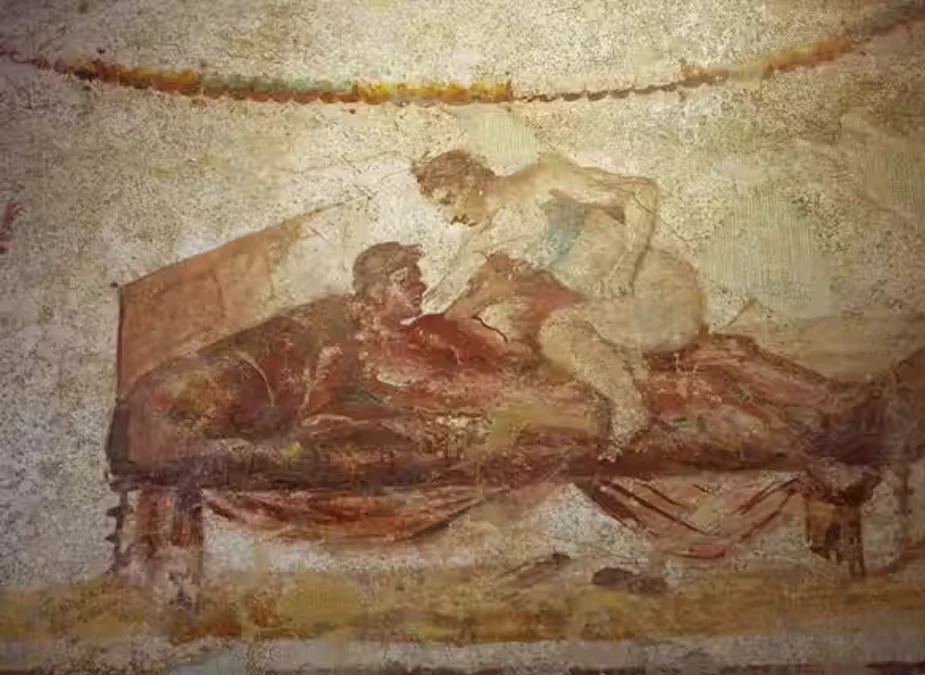The brothels, or the Lupanars, offer fascinating insights into the world of prostitution in antiquity.
Located in the southern part of Pompeii, near the forum, they offered sexual services from both female and male “lupae” (prostitutes).
From the cleverly designed rooms to the suggestive graffiti, they hold many secrets waiting to be uncovered.
This article will explore everything about the brothels in Pompeii, helping you plan a smooth voyage.
Discovery and Excavations
The renowned Lupanar was first discovered in the 18th century during the Bourbon excavations.
Located in the Regio V district on Vicolo del Lupanare, it provides insights into the socio-economic dynamic of prostitution in Pompeii.
Subsequent excavations unearthed numerous frescoes, inscriptions, and architectural layouts of the Lupanar.
Researchers gained valuable insights into the working conditions and the symbolism associated with the artifacts.
These insights have enabled them to create a more comprehensive picture of daily life in ancient Pompeii.
Design and Size
The structure’s purpose can be easily identified due to its detailed inscriptions and explicit frescoes.
Its ground floor has a long corridor flanked by several small rooms.
The second floor can be reached through a now non-existent staircase that mirrors the ground floor layout.
The rooms are sparsely furnished with a lamp and a bed and some explicit inscriptions indicating the services offered along with the advertisement.
The Lupanar is smaller than other Pompeii buildings, and its architecture reflects its commercial functionality.
Graffiti and Artwork

The graffiti is both explicit and informative, providing a window into the inhabitant’s daily lives.
It offers insights into their experiences, preferences, interactions, and information on specific services and prices.
Some graffiti also represents clients’ appraisals of certain women, their abilities, and even sexual advice.
The decorative artwork also serves as the services’ menu, allowing clients to select their preferred encounter.
Researchers have suggested that the clientele was mostly male, with a focus on heterosexual encounters.
Also, most of the workers were slaves of Greek origin and were forced to be confined within the building premises.
What can we do at the brothels?
A visit to the brothels in Pompeii will equip you with unique insights into the daily lives of the city’s residents.
You can appreciate the architecture of the Lupanar and understand its functionality as a place of prostitution.
Likewise, you can admire and interpret the exotic frescoes that adorned the brothel’s walls.
You can analyze the openness and cultural attitude of the inhabitants by examining these artworks.
Visiting the brothel will take your Pompeii exploration to a whole new level.
FAQs
1. What services did the brothels offer?
As evidenced by the explicit frescoes and graffiti on the walls, the brothels offered a variety of sexual services.
It appears that heterosexual encounters were the primary focus of these artworks.
2. Who were the clients of the Pompeii brothels?
According to the graffiti and the services provided, the clients were primarily male.
3. Were the sex workers in Pompeii brothels slaves?
Many of the sex workers were likely slaves with Greek names, kept on the premises by male pimps.
4. How were the brothels decorated?
Clients may have selected their desired encounters from a menu of explicit frescoes depicting sexual acts in brothels.
5. Were the brothels legal in ancient Rome?
Several cities, including Pompeii, had open brothels where prostitution was legal and regulated.
6. How were the rooms in the brothels arranged?
Lupanar, Pompeii’s largest brothel, had a central corridor flanked by small, sparsely furnished rooms on the ground floor, where prostitution activities probably occurred.
Featured Image:




